Russia is constructing new power lines in occupied southeastern Ukraine to connect the captured Zaporizhzhia nuclear power plant (ZNPP) to its own electrical grid, according to Greenpeace and The New York Times.
A new satellite analysis by Greenpeace reveals that Russia has built 90 km (55 miles) of high-voltage electricity lines and pylons between the occupied Ukrainian cities of Mariupol and Berdiansk, providing concrete evidence of Moscow’s plans to restart the facility and connect it to the Russian electrical grid.

to connect the Zaporizhzhia nuclear plant to Rostov in Russia. Source: Planet/Greenpeace Ukraine
Recent imagery from 11-12 May is showing 15 additional pylons and over 5 km (3 miles) of new lines east of Topolyne, north of Mariupol.
Based on the construction’s location and direction, Greenpeace determined the project aims to link the new power lines to a large substation near Mariupol that connects to the Zaporizhzhia nuclear plant, located about 225 km (140 miles) west.

Russia plans to restart Ukrainian occupied nuclear plant
Russian officials have explicitly stated their intention to restart the plant. In December 2024, Sergey Kiriyenko, First Deputy Chief of Staff of the Presidential Executive Office, stated Russia’s intention to restart the reactors “as fast as possible.”
On 21 May 2025, Rosatom CEO Alexey Likhachev told the Russian Federation Council that “everyone is living the dream of raising the station,” and reported that Russia has developed a plan to bring the plant to full capacity. He noted that a plan had been developed to return the facility to full capacity, but acknowledged the main challenge was the need to “replace the power grid.”
“This is some of the first hard evidence of Russian moving ahead with its dangerous and illegal plans for restarting Ukraine and Europe’s largest nuclear plant at Zaporizhzhia,” said Shaun Burnie, nuclear specialist at Greenpeace Ukraine.
Burnie also argued that “the plant is the sole property of Ukraine” and called for Russia to be stopped from its restart plans.
What are the risks of restarting the nuclear plant after years of occupation?
Energy experts warn that restarting the Zaporizhzhia plant would carry significant risks. After more than three years of war, critical equipment remains unreplaced and many experienced Ukrainian staff members have fled.
The 2023 destruction of a nearby Kakhovka dam on the Dnipro River also deprived the plant of its main water source needed to cool reactors and spent fuel rods.
Jan Vande Putte, nuclear expert at Greenpeace Ukraine, stated that “it is impossible for Rosatom to meet nuclear safety guidelines in seeking to restart ZNPP.” He called on the International Atomic Energy Agency to explicitly communicate this to Russian government representatives and to avoid supporting any preparations for reactor restart.
Ukrainian Energy Minister Herman Galushchenko stated that “any attempts by Russian representatives to restart power units could lead to unpredictable consequences.”
The plant’s proximity to active fighting also raised international concerns about potential nuclear disaster, with experts warning against any restart attempts under current conditions.
Russia ignores Trump’s peace proposal for ZNPP
The power line construction conflicts with recent US diplomatic efforts regarding the plant’s future. The Trump administration expressed interest in the United States taking control of Ukrainian nuclear plants and presented a seven-point peace plan calling for Russia to return the plant to Ukraine under US management, with the facility supplying electricity to both Ukraine and Russia.
Russian officials have consistently rejected surrendering control over the facility, with Foreign Minister Sergey Lavrov telling CBS News that the plant was being run by Rosatom and that he did not think “any change is conceivable.”
The Institute for the Study of War suggested that Russia is positioning itself for permanent control over the facility and signalling intentions to occupy and annex additional Ukrainian territory.
Russian officials have also intensified rhetoric about historical claims to “Novorossiya,” [New Russia] defined by Moscow as encompassing all of eastern and southern Ukraine, according to ISW.

Russian occupation authorities have recently advocated for Russian control over areas of Dnipropetrovsk Oblast near the Dnipro River that Russia has not yet annexed. The Russian definition of Novorossiya includes territory directly across from the nuclear plant on the west bank of the Dnipro River.
Russia’s efforts to connect the plant to its power grid suggest Moscow expects either to push the frontline significantly away from the facility or to occupy and annex Dnipropetrovsk Oblast to ensure safe operation of the nuclear complex.




